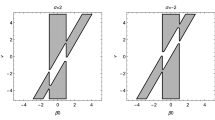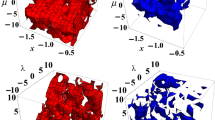Abstract
We investigate cosmological evolution in the scalar–tensor theory with the field derivative coupling to the double-dual of the Riemann tensor (the cubic-type theory). The theory can be seen as the straightforward extension of the scalar–tensor with the quadratic order field derivative coupling to the Einstein tensor (the quadratic-type theory). Both the field derivative couplings to the Einstein tensor and the double-dual of the Riemann tensor have been argued in terms of the successful realization of the self-tuning of the cosmological constant within the Horndeski theory. Assuming the constant potential given by the sum of the cosmological constant and the quantum vacuum energy, the shift symmetry for the scalar field and no matter fields, in the spatially-flat Friedmann–Lemaître–Robertson–Walker spacetime, we can reduce the set of the field equations to the first-order ordinary nonlinear differential equation for the Hubble parameter, showing the existence of the self-tuned and runaway de Sitter solutions, in addition to the standard de Sitter solutions in general relativity and the finite Hubble singularities which can be reached within the finite time. We then argue the possible cosmological evolution in terms of the values of the effective cosmological constant, the kinetic coupling constants and the initial Hubble parameter. Although the behavior of the universe around each of the de Sitter solutions as well as the finite time singularities is very similar in both theories, we find that the crucial difference appears in terms of no bounce or turnaround behavior across the vanishing Hubble parameter as well as no limitation for the range of the Hubble parameter in the cubic-type theory.
Similar content being viewed by others
References
Hinshaw, G., et al.: [WMAP Collaboration]. Astrophys. J. Suppl. 208, 19 (2013). [arXiv:1212.5226 [astro-ph.CO]]
Ade, P.A.R., et al.: [Planck Collaboration]. Astron. Astrophys. 571, A16 (2014). [arXiv:1303.5076 [astro-ph.CO]]
Ade, P.A.R., et al.: [Planck Collaboration]. arXiv:1502.01589 [astro-ph.CO]
Tsujikawa, S.: Lect. Notes Phys. 800, 99 (2010). [arXiv:1101.0191 [gr-qc]]
Clifton, T., Ferreira, P.G., Padilla, A., Skordis, C.: Phys. Rept. 513, 1 (2012). [arXiv:1106.2476 [astro-ph.CO]]
Brans, C., Dicke, R.H.: Phys. Rev. 124, 925 (1961)
Hanlon, J.O’.: Phys. Rev. Lett. 29, 137 (1972)
Dvali, G.R., Gabadadze, G., Porrati, M.: Phys. Lett. B 485, 208 (2000). [arXiv:hep-th/0005016]
Nicolis, A., Rattazzi, R., Trincherini, E.: Phys. Rev. D 79, 064036 (2009). [arXiv:0811.2197 [hep-th]]
de Rham, C., Gabadadze, G., Tolley, A.J.: Phys. Rev. Lett. 106, 231101 (2011). [arXiv:1011.1232 [hep-th]]
de Rham, C., Heisenberg, L.: Phys. Rev. D 84, 043503 (2011). [arXiv:1106.3312 [hep-th]]
Kallosh, R., Linde, A.: JCAP 1307, 002 (2013). [arXiv:1306.5220 [hep-th]]
Kallosh, R., Linde, A.: JCAP 1310, 033 (2013). [arXiv:1307.7938 [hep-th]]
Ade, P.A.R., et al.: [Planck Collaboration]. arXiv:1502.02114 [astro-ph.CO]
Starobinsky, A.A.: Phys. Lett. B 91, 99 (1980)
Bezrukov, F.L., Shaposhnikov, M.: Phys. Lett. B 659, 703 (2008). [arXiv:0710.3755 [hep-th]]
Beutler, F., et al.: [BOSS Collaboration]. Mon. Not. R. Astron. Soc. 443, 1065 (2014). [arXiv:1312.4611 [astroph.CO]]
Samushia, L., et al.: Mon. Not. R. Astron. Soc. 439, 3504 (2014). [arXiv:1312.4899 [astro-ph.CO]]
Macaulay, E., Wehus, I.K., Eriksen, H.K.: Phys. Rev. Lett. 111, 161301 (2013). [arXiv:1303.6583 [astroph.CO]]
Vikhlinin, A., et al.: Astrophys. J. 692, 1060 (2009). [arXiv:0812.2720 [astro-ph]]
Ade, P.A.R., et al.: [Planck Collaboration]. Astron. Astrophys. 571, A16 (2014). [arXiv:1303.5076 [astro-ph.CO]]
Ade, P. A.R., et al.: [Planck Collaboration]. arXiv:1502.01589 [astro-ph.CO]
Vainshtein, A.I.: Phys. Lett. B 39, 393 (1972)
Brax, P., van de Bruck, C., Davis, A.-C., Khoury, J., Weltman, A.: Phys. Rev. D 70, 123518 (2004). [arXiv:astro-ph/0408415]
Horndeski, G.W.: Int. J. Theor. Phys. 10, 363 (1974)
Deffayet, C., Esposito-Farese, G., Vikman, A.: Phys. Rev. D 79, 084003 (2009). [arXiv:0901.1314 [hep-th]]
Deffayet, C., Deser, S., Esposito-Farese, G.: Phys. Rev. D 80, 064015 (2009). [arXiv:0906.1967 [gr-qc]]
Deffayet, C., Gao, X., Steer, D.A., Zahariade, G.: Phys. Rev. D 84, 064039 (2011). [arXiv:1103.3260 [hep-th]]
Kobayashi, T., Yamaguchi, M., Yokoyama, J’i: Prog. Theor. Phys. 126, 511 (2011). [arXiv:1105.5723 [hep-th]]
Kobayashi, T., Yamaguchi, M., Yokoyama, J’i: Phys. Rev. Lett. 105, 231302 (2010). [arXiv:1008.0603 [hep-th]]
Burrage, C., de Rham, C., Seery, D., Tolley, A.J.: JCAP 1101, 014 (2011). [arXiv:1009.2497 [hep-th]]
Creminelli, P., Nicolis, A., Trincherini, E.: JCAP 1011, 021 (2010). [arXiv:1007.0027 [hep-th]]
Silva, F.P., Koyama, K.: Phys. Rev. D 80, 121301 (2009). [arXiv:0909.4538 [astro-ph.CO]]
Gannouji, R., Sami, M.: Phys. Rev. D 82, 024011 (2010). [arXiv:1004.2808 [gr-qc]]
Chow, N., Khoury, J.: Phys. Rev. D 80, 024037 (2009). [arXiv:0905.1325 [hep-th]]
De Felice, A., Kobayashi, T., Tsujikawa, S.: Phys. Lett. B 706, 123 (2011). [arXiv:1108.4242 [gr-qc]]
Lovelock, D.: J. Math. Phys. 12, 498 (1971)
Lovelock, D.: J. Math. Phys. 13, 874 (1972)
Zwiebach, B.: Phys. Lett. B 156, 315 (1985)
Zumino, B.: Phys. Rep. 137, 109 (1986)
Gross, D.J., Sloan, J.H.: Nucl. Phys. B 291, 41 (1987)
Tseytlin, A.A.: Nucl. Phys. B 584, 233 (2000). [arXiv:hep-th/0005072]
Van Acoleyen, K., Van Doorsselaere, J.: Phys. Rev. D 83, 084025 (2011). [arXiv:1102.0487 [gr-qc]]
Charmousis, C., Gouteraux, B., Kiritsis, E.: JHEP 1209, 011 (2012). [arXiv:1206.1499 [hep-th]]
Charmousis, C.: arXiv:1405.1612 [gr-qc]
Charmousis, C., Copeland, E.J., Padilla, A., Saffin, P.M.: Phys. Rev. Lett. 108, 051101 (2012). [arXiv:1106.2000 [hep-th]]
Charmousis, C., Copeland, E.J., Padilla, A., Saffin, P.M.: Phys. Rev. D 85, 104040 (2012). [arXiv:1112.4866 [hep-th]]
Amendola, L., Charmousis, C., Davis, S.C.: JCAP 0612, 020 (2006). [arXiv:hep-th/0506137]
Carter, B.M.N., Neupane, I.P.: JCAP 0606, 004 (2006). [arXiv:hep-th/0512262]
Koivisto, T., Mota, D.F.: Phys. Rev. D 75, 023518 (2007). [arXiv:hep-th/0609155]
Appleby, S.: JCAP 1505(05), 009 (2015). [arXiv:1503.06768 [gr-qc]]
Sushkov, S.V.: Phys. Rev. D 80, 103505 (2009). [arXiv:0910.0980 [gr-qc]]
Saridakis, E.N., Sushkov, S.V.: Phys. Rev. D 81, 083510 (2010)
Germani, C., Kehagias, A.: Phys. Rev. Lett. 105, 011302 (2010). [arXiv:1003.2635 [hep-ph]]
Germani, C., Watanabe, Y.: JCAP 1107, 031 (2011). [Addendum-ibid. 1107, A01 (2011)] [arXiv:1106.0502 [astro-ph.CO]]
Koutsoumbas, G., Ntrekis, K., Papantonopoulos, E.: JCAP 1308, 027 (2013). [arXiv:1305.5741 [gr-qc]]
Jinno, R., Mukaida, K., Nakayama, K.: JCAP 1401(01), 031 (2014). [arXiv:1309.6756 [astro-ph.CO]]
Nojiri, S., Odintsov, S.D., Tsujikawa, S.: Phys. Rev. D 71, 063004 (2005). [arXiv:hep-th/0501025]
Deffayet, C., Pujolas, O., Sawicki, I., Vikman, A.: JCAP 1010, 026 (2010). [arXiv:1008.0048 [hep-th]]
Martin-Moruno, P., Nunes, N.J., Lobo, F.S.N.: Phys. Rev. D 91(8), 084029 (2015). [arXiv:1502.03236 [gr-qc]]
Martn-Moruno, P., Nunes, N.J., Lobo, F.S.N.: JCAP 1505(05), 033 (2015). [arXiv:1502.05878 [gr-qc]]
Babichev, E., Charmousis, C.: JHEP 1408, 106 (2014). [arXiv:1312.3204 [gr-qc]]
Acknowledgments
This work was supported by the Fundação para a Ciência e a Tecnologia (FCT) through Grant No. SFRH/BPD/88299/2012.
Author information
Authors and Affiliations
Corresponding author
Appendices
Appendix 1: The quadratic-type theory
1.1 Cosmological equations
In the section, we review cosmological evolution in the quadratic-type theory (1) with the gravitational Lagrangian (9). This theory can be seen as the simplified counterpart of the cubic-type theory (10) considered in the main text. Again we purely focus on the gravity sector and set \({\mathcal {L}}_m=0\) in (1).
Assuming the spatially-flat FLRW spacetime (8) with the general scale factor a(t) and the homogeneous scalar field \(\phi (t)\), the gravitational and the scalar field equations of motion reduce to
respectively. Moreover, we assume the shift symmetry and the constant potential (20), where again \(\Lambda \) is given by the sum of the classical and quantum contributions as (21). Introducing \(\psi _2=\dot{\phi }^2\), then the Friedmann equation (40) can be rewritten as
where \(\xi _2:=\frac{\alpha _2}{\alpha _G}\). \(\psi _2\) and \(\xi _2\) are analogous to \(\psi _3=\dot{\phi }^3\) and \(\xi _3=\frac{\alpha _3}{\alpha _P}\) in the cubic-type theory, but in the reflection-symmetric quadratic-type theory, by definition, \(\psi _2\ge 0\), which does not allow the solutions for the certain range of H. For instance, assuming that \(\alpha _G<0\), \(\alpha _2>0\) and \(\Lambda >0\), the solution must exist within
Combining (41) and (42) with (43) and eliminating \(\psi _2\), we obtain the evolution equation for H
After (45) is integrated for a given initial value of H, \(\psi _2\) and hence \(\dot{\phi }\) can be obtained from (43).
For the pure standard kinetic term, \(\alpha _G=0\),
The only de Sitter solutions are the GR ones \(H=\pm \sqrt{\frac{\Lambda }{3}}\). The expanding de Sitter solution can be the late-time attractor. For the kinetic term of the correct sign, \(\alpha _2<0\) because of our convension, \(\psi _2\ge 0\) for \(|H|\ge \sqrt{\frac{\Lambda }{3}}\), which forbids the bounce and turnaround evolutions across \(H=0\). On the other hand, for the wrong sign kinetic term \(\alpha _2>0\), \(|H|\le \sqrt{\frac{\Lambda }{3}}\), and the bounce solution is allowed [54, 55].
1.2 Stationary solutions
For \(\alpha _G\ne 0\), the stationary solutions where \(\dot{H}=0\) are obtained from \(F_J (H)=0\),
for which
respectively. Thus as in the cubic-type theory, they are the GR, self-tuned and runaway de Sitter solutions, respectively. For the self-tuned solution \(H=\pm \sqrt{\frac{\xi _2}{3}}M_2\), a sudden jump of the effective cosmological constant \(\Lambda \), \(\Lambda \rightarrow \Lambda +\Delta \Lambda \), is compensated by a jump of \(\psi _2\), \(\psi _2\rightarrow \psi _2-\frac{2m_p^2}{\alpha _2} \Delta \Lambda \).
The GR and self-tuned expanding de Sitter solutions \(H=\sqrt{\frac{\Lambda }{3}}, \sqrt{\frac{\xi _2}{3}}M_2\) and the contracting runaway solution \(H=-\frac{\sqrt{\xi _2}}{3}M_2\), can be the late-time attractors, while the other solutions can describe the early-time evolution.
1.3 Finite time singularities
The first class of the singularities is given by the poles of \(F_J(H)\) defined in (45), where \(\dot{H}\) diverges within the finite time. There are at most the four finite H singularities expressed by \(H=\pm H_+,\pm H_-\), where we have defined
These correspond to the Type II singularities. The finite H singularities in the quadratic-type theory are summarized in Tables 31, 32 and 33. \(H=H_+, -H_-\) correspond to the initial singularities, and \(H=-H_+,H_-\) correspond to the future singularities. For \(\xi _2=0\), they reduce to \(H=\sqrt{\frac{\Lambda }{6}}\) and \(H=-\sqrt{\frac{\Lambda }{6}}\), respectively.
The other possible finite time singularities are of \(H\rightarrow \pm \infty \). Irrespective of \(\Lambda \) and \(\xi _2\), \(\dot{H}\approx -\frac{3}{2}H^2<0\) and hence the expanding universe never reaches \(H\rightarrow \infty \). The contracting universe with a sufficiently large negative expansion rate collapses as \(a\propto (-t)^{\frac{2}{3}}\). The singularity of \(H\rightarrow -\infty \) corresponds to the Type III singularity. Thus as for the cubic-type theory the expansion of the universe cannot reach the super-acceleration phase.
1.4 Behaviors around \(H=0\)
We then investigate the behavior around \(H=0\). If \(\xi _2\ne 0\), for \(\Lambda \ne M_2^2\xi _2\), \(H\approx \frac{M_2^2\Lambda \xi _2}{-\Lambda +M_2^2\xi _2} t\). Thus the cosmological evolution can be either bounce or turnaround, which are summarized in Tables 34 and 35. On the other hand for \(\Lambda = M_2^2\xi _2\), \(H\approx \big \{\frac{M_2^4\xi _2^2}{6}(-t)\big \}^{\frac{1}{3}}\), and hence no smooth transition across \(H=0\) takes place.
If \(\xi _2=0\), there is the solution \(H=0\), and \(\dot{H}\approx -3H^2\). Thus the expanding universe approaches the decerelated expansion phase \(a\approx t^{\frac{1}{3}}\), and the contracting universe can initially behave as \(a\approx (-t)^{\frac{1}{3}}\).
1.5 Cosmological evolution
For the various initial values of H, the cosmological evolution is summarized in Tables 36, 37, 38, 39, 40, 41, 42, 43, 44, 45 and 46, which crucially depends on the value of \(\Lambda \) and \(\xi _2\). The essential feature of the cosmological evolution remains the same as the cubic-type theory, except for the behavior in the vicinity of \(H=0\), which allows for the bounce or turnaround of the scale factor a.
1.6 \(\psi _2\) and the solution space of H
Finally, we investigate the realizability of the solutions for \(\alpha _G<0\). The sign of \(\psi _2\) for \(\alpha _G<0\) is summarized in Tables 47, 48, 49, 50 and 51. From (43), for \(\alpha _G>0\) we may flip the sign in these tables. As \(\psi _2\ge 0\), the solutions only for the certain range of H are allowed.
If \(\xi _2>0\),
-
1.
For \(\Lambda \le 0\) the solutions of \(|H|<\frac{\sqrt{\xi _2}}{3}M_2\) are allowed.
-
2.
For \(0<\Lambda <\frac{\xi _2}{3}M_2^2\) the solutions of \(\sqrt{\frac{\Lambda }{3}}<|H|<\frac{\sqrt{\xi _2}}{3}M_2\) are allowed.
-
3.
For \(\Lambda =\frac{\xi _2}{3}M_2^2\) there is no solution of \(\alpha _G<0\) for all H.
-
4.
For \(\Lambda >\frac{\xi _2}{3}M_2^2\) the solutions of \(\frac{\sqrt{\xi _2}}{3}M_2<|H|<\sqrt{\frac{\Lambda }{3}}\) are allowed.
If \(\xi _2\le 0\),
-
1.
For \(\Lambda >0\) there is no solution of \(|H|>\sqrt{\frac{\Lambda }{3}}\).
-
2.
For \(\Lambda \le 0\) there is no solution of \(\alpha _G<0\) for all H.
One of the important observations from these tables is that for the standard term with the correct sign, \(\alpha _2<0\) again because of our convention, namely \(\alpha _G<0\) and \(\xi _2>0\) or \(\alpha _G>0\) and \(\xi _2<0\), the allowed region does not involve the bounce and turnaround evolution across \(H=0\). The other important observation from Table 47 is that for \(\alpha _2<0\), \(\Lambda \le 0\) and \(\xi _2>0\) (hence \(\alpha _G<0\)), the self-tuned solution \(H=\sqrt{\frac{\xi _2}{3}}M_2\) is forbidden, as \(\psi _2\ge 0\) requests \(|H|<\frac{\sqrt{\xi _2}}{3}M_2\).
Appendix 2: The stability of the self-tuned de Sitter solution
In the section, we discuss the stability of the self-tuned de Sitter solution
where \(a_0\) and \(\phi _0\) are the integration constants. Following the formulation in [29], the theory (10) is given by the choice of the four functions in the Horndeski theory
The conditions for the absence of the ghost and gradient instabilities are given by
for the tensor perturbations and
for the scalar perturbations, respectively, where \({\mathcal {F}}_T\), \({\mathcal {G}}_T\), \({\mathcal {F}}_S\) and \({\mathcal {G}}_S\) were given in (4.4), (4.5), (4.32) and (4.33) in Ref. [29].
By substituting the solutions (50), for both the expanding and contracting branches, we find
Thus the stability condition for the tensor perturbation \({\mathcal {F}}_T>0\) and \({\mathcal {G}}_T>0\) is found to be
On the other hand, the stability condition for the scalar perturbation \({\mathcal {F}}_S>0\) and \({\mathcal {G}}_S>0\) is found to be
Thus the stability region of the solution (50) is given by (56). We emphasize that for \(\Lambda =2M_3^2\xi _3\) the self-tuned de Sitter solution coincides with the de Sitter solution in GR, \(H=\sqrt{\frac{\Lambda }{3}}\). As expected, the stability region (56) includes the case of de Sitter solution in GR.
Rights and permissions
About this article
Cite this article
Minamitsuji, M. Cosmological evolution with the cubic order field derivative coupling. Gen Relativ Gravit 48, 26 (2016). https://doi.org/10.1007/s10714-016-2025-6
Received:
Accepted:
Published:
DOI: https://doi.org/10.1007/s10714-016-2025-6




